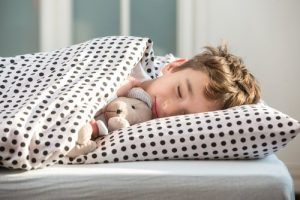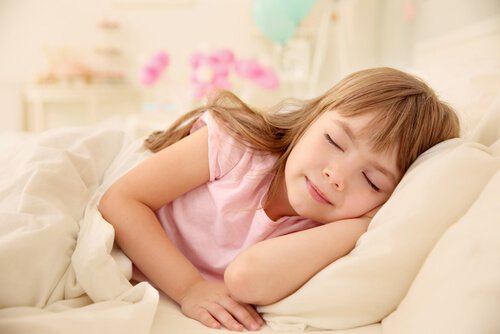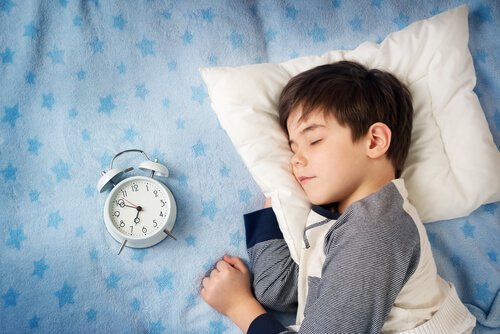How to Detect and Treat Sleep Apnea in Children

Pediatric apnea, also known as obstructive sleep apnea in children, means breathing is interrupted during rest. It affects about 2% of children around the world and specialists believe that many cases go undiagnosed.
How can breathing get interrupted? This happens because the airways are either partially or completely obstructed. Consequently, the air cannot go through normally and it usually causes the child to wake up periodically.
When we sleep, our muscles relax. However, the muscles involved in breathing stay active, since this is a vital function. This problem usually affects children with tight throats, since they can’t get as much air in as they should.
Sleep apnea in children can also be caused by the presence of adenoids, inflammation of the tonsils, the shape of the palate or deficient muscle tone (which is often a symptom of a serious underlying syndrome).
What are the symptoms of sleep apnea in children?
It can be difficult to detect sleep apnea in children. These are the most common symptoms:
- Snoring, caused by breathing problems. Not every child who snores suffers from sleep apnea. Other conditions can also cause snoring in children.
- Not resting properly, trouble sleeping, frequently waking up at night.
- Sleep-walking.
- Sweating.
- Enuresis: Involuntary urination during sleep.
“Sleep apnea in children is caused by the partially or completely obstructed airways.”

Daytime symptoms
There are other symptoms, perhaps easier to detect, that can be noticed during daytime. It is then when the child will show the real consequences of not being properly rested.
You should pay attention to any of these signals:
- Fatigue, weariness, irritability: Not enough rest can affect the child’s mood, as well as his or her willingness to engage in activities. Sometimes this even affects the activities he actually enjoys.
- Headaches: They can come and go for the whole day, and sometimes they can be very intense.
- Trouble learning, concentrating and paying attention: If a child who used to do well at school shows these symptoms, it can be a sign of him or her not sleeping properly.
- Behavioral problems. Also linked to the previous symptoms, the negative consequences of not getting enough sleep can also affect the patient’s behavior.
How to treat sleep apnea in children
If you’ve detected the symptoms we mentioned earlier, you should take your child to a pediatrician. Some people also recommend seeing an otolaryngologist, a pediatric pulmonologist, a neurologist or other specialists with expertise in sleep disorders.
The most common test to detect sleep apnea in children is the polysomnogram. It allows doctors to evaluate how the patient’s vital organs work while he rests. This way, they can discover any anomalies in the organs, including the airways.
Once the doctors have identified the problem, we can treat sleep apnea in children in the following ways:
- Removal of the adenoids or tonsils. Since apnea can be caused by the inflammation of either, removing them is usually a solution. This is a very common procedure nowadays and it entails no risk for the child. It’s also highly effective as a treatment for sleep apnea in children.
- Continuous Positive Airway Pressure. Also known as CPAP. In this treatment the child wears a mask during sleep. It puts pressure on the nose and, essentially, pushes the air into the lungs, thus forcing the patient to breathe. This is mostly used when operating on the adenoids or tonsils hasn’t had any effect or isn’t possible.
- Other surgeries. In addition to tonsil removal, there is another surgical procedure that removes the excess tissue on the back of the throat, which is blocking the airway. Other options are correcting palate structural anomalies and, in very serious cases, opening up the trachea to allow breathing. This, however, is very rarely used.
- Dental devices. This is the easiest treatment of all. It’s a device, similar to the protection athletes wear, that keeps the airway open.

More advice
There are other procedures worth mentioning that can help children get better, even though they don’t actually constitute a cure. For example, losing weight will improve sleep apnea in obese children.
Furthermore, children suffering from Down syndrome, cerebral palsy or craniofacial deformities are particularly prone to sleep apnea. In these cases a professional will recommend the best treatment, according to the child’s needs and circumstances.
Pediatric apnea, also known as obstructive sleep apnea in children, means breathing is interrupted during rest. It affects about 2% of children around the world and specialists believe that many cases go undiagnosed.
How can breathing get interrupted? This happens because the airways are either partially or completely obstructed. Consequently, the air cannot go through normally and it usually causes the child to wake up periodically.
When we sleep, our muscles relax. However, the muscles involved in breathing stay active, since this is a vital function. This problem usually affects children with tight throats, since they can’t get as much air in as they should.
Sleep apnea in children can also be caused by the presence of adenoids, inflammation of the tonsils, the shape of the palate or deficient muscle tone (which is often a symptom of a serious underlying syndrome).
What are the symptoms of sleep apnea in children?
It can be difficult to detect sleep apnea in children. These are the most common symptoms:
- Snoring, caused by breathing problems. Not every child who snores suffers from sleep apnea. Other conditions can also cause snoring in children.
- Not resting properly, trouble sleeping, frequently waking up at night.
- Sleep-walking.
- Sweating.
- Enuresis: Involuntary urination during sleep.
“Sleep apnea in children is caused by the partially or completely obstructed airways.”

Daytime symptoms
There are other symptoms, perhaps easier to detect, that can be noticed during daytime. It is then when the child will show the real consequences of not being properly rested.
You should pay attention to any of these signals:
- Fatigue, weariness, irritability: Not enough rest can affect the child’s mood, as well as his or her willingness to engage in activities. Sometimes this even affects the activities he actually enjoys.
- Headaches: They can come and go for the whole day, and sometimes they can be very intense.
- Trouble learning, concentrating and paying attention: If a child who used to do well at school shows these symptoms, it can be a sign of him or her not sleeping properly.
- Behavioral problems. Also linked to the previous symptoms, the negative consequences of not getting enough sleep can also affect the patient’s behavior.
How to treat sleep apnea in children
If you’ve detected the symptoms we mentioned earlier, you should take your child to a pediatrician. Some people also recommend seeing an otolaryngologist, a pediatric pulmonologist, a neurologist or other specialists with expertise in sleep disorders.
The most common test to detect sleep apnea in children is the polysomnogram. It allows doctors to evaluate how the patient’s vital organs work while he rests. This way, they can discover any anomalies in the organs, including the airways.
Once the doctors have identified the problem, we can treat sleep apnea in children in the following ways:
- Removal of the adenoids or tonsils. Since apnea can be caused by the inflammation of either, removing them is usually a solution. This is a very common procedure nowadays and it entails no risk for the child. It’s also highly effective as a treatment for sleep apnea in children.
- Continuous Positive Airway Pressure. Also known as CPAP. In this treatment the child wears a mask during sleep. It puts pressure on the nose and, essentially, pushes the air into the lungs, thus forcing the patient to breathe. This is mostly used when operating on the adenoids or tonsils hasn’t had any effect or isn’t possible.
- Other surgeries. In addition to tonsil removal, there is another surgical procedure that removes the excess tissue on the back of the throat, which is blocking the airway. Other options are correcting palate structural anomalies and, in very serious cases, opening up the trachea to allow breathing. This, however, is very rarely used.
- Dental devices. This is the easiest treatment of all. It’s a device, similar to the protection athletes wear, that keeps the airway open.

More advice
There are other procedures worth mentioning that can help children get better, even though they don’t actually constitute a cure. For example, losing weight will improve sleep apnea in obese children.
Furthermore, children suffering from Down syndrome, cerebral palsy or craniofacial deformities are particularly prone to sleep apnea. In these cases a professional will recommend the best treatment, according to the child’s needs and circumstances.
All cited sources were thoroughly reviewed by our team to ensure their quality, reliability, currency, and validity. The bibliography of this article was considered reliable and of academic or scientific accuracy.
- Sans-Capdevila, O., & Gozal, D. (2008). Consecuencias neurobiológicas del síndrome de apnea del sueño infantil. Rev Neurol, 47(12), 659-64.
- Llombart, M., Chiner, E., Gómez-Merino, E., Andreu, A., Pastor, E., Senent, C., … & Signes-Costa, J. (2007). Síndrome de apneas-hipopneas durante el sueño en población infantil: diferencias en su expresión entre niños con hipertrofia amigdalar y con enfermedad concomitante. Archivos de Bronconeumología, 43(12), 655-661.
This text is provided for informational purposes only and does not replace consultation with a professional. If in doubt, consult your specialist.








